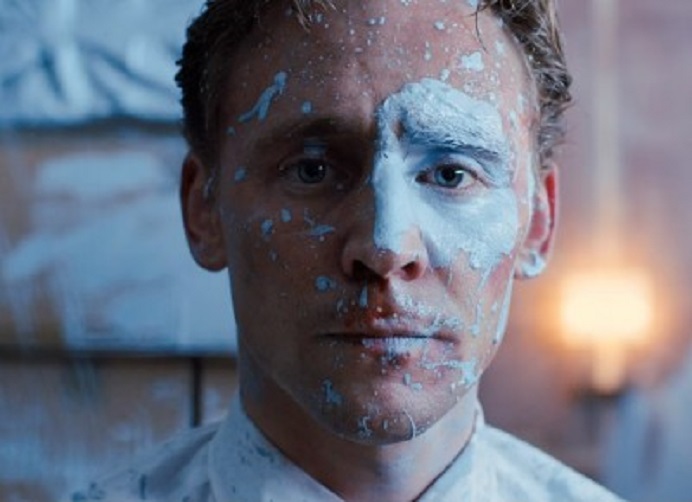FIVE STARS
Wheatley’s High Rise is a fast-paced dystopian thriller, using dark wit and farce to forward a pessimistic view of human nature. Evident from many of Ballard’s other novels, he regarded humanity as quite uncivilised. Given the right circumstances, all our bourgeois morality and manners – all that ‘self-indulgent toilet training’ as he called it – will simply slip away to reveal our true, inner selves. Behind the façade lies barbaric violence, animalistic ritual, and behaviour determined by the ‘logic’ of primal urges, all of which are realised in the tower complex. Cinema has a habit of using Brutalist architecture to realise dystopian fantasies, think A Clockwork Orange or Total Recall. But for Ballard, the building itself is responsible for the transformation into primalism. It reconditions its inhabitants in the new patterns of behaviour necessary to survive. Those that can adapt, will live and thrive. Those that cannot become another of the building’s many victims – martyrs on the path to the new order.
Wheatley’s film brings bags of style to Ballard’s substance. The cinematography is a treat for the eye throughout. Montage, the splicing together of quick shots traversing time, space, and sometimes reality, is cleverly used. Accompanied by Mansell’s soundtrack, it maintains a fast-paced intensity, mirroring the high rise’s rapid descent into anarchy. One sequence is particularly commendable, a stabbing viewed from the vantage point of a kaleidoscope, which stands out stylistically in a film already drenched with violence. High Rise also offers some commendable performances; Irons shines as the enigmatic Royal, Miller dazzles as the social-climber Melville, and Evans steals the show as the brutish Wilder. Hiddleston plays Laing, the middle-man seeking anonymity – who finds it when he adapts and thrives. Though cast slightly against type, as we’re far more used to seeing Hiddleston as a suave sophistocrat, there’s nothing jarring in his performance.
But for me, Wheatley never makes convincing the necessity of the new tribalism. The viewer finds it hard to empathise with the onset of a ‘logic more powerful than reason’. The start of discontent in the high rise is quite unexpected, happening suddenly over a game of squash. Unable to demonstrate that adapting was necessary to survival in the tower, Wheatley makes it seem more a competition over better parties than the inevitable collapse of social etiquette. This makes the final third a confusing orgy of drunkenness, sex and violence – rather than tribal logic fulfilled as Ballard intended. So does Wheatley prioritise style over substance? Perhaps. At times I was even bored by their anarchic behaviour, feeling disconnected from their primordial logic.
Is there a message amongst all this carnage? With the film ripe for speculation, enthusiastic viewers have plenty of ammo to try and decipher its ‘message’. Is this social comment? Wheatley portrays the warring floors as having a strong class dynamic. Wilder and the lower-floors find themselves in conflict with the building’s upper-floor aristocrats for electricity, alcohol, and the allegiance of the middle-floors. Indeed, it’s the inequality and rigid hierarchy which set in motion the dissolving of normal morality. But come the end all floors come to resemble a single survivalist class, tribal and barbaric. Or perhaps the high rise represents different layers of the human psyche? Borrowing from Freudian psychoanalysis, Ballard himself suggested the upper floors were the moralising superego, and the lower floors the id, man’s primal desires. In this interpretation the middle floors act as the ego, the mediator between the two. Laing’s job as a physiologist is no coincidence, and the parallels to Scottish psychiatrist R.D. Laing are obvious. But audiences searching for a political message in Ballard’s dystopian vision will be disappointed. Like all good art, High Rise is ambiguous and open to interpretation.
The film rides the wave of the Brutalist revival. Wheatley’s found the perfect time to make High Rise, at the peak of the reappraisal of Brutal post-war architecture, now admired for its haunting concrete beauty and brutal functionality. In fact High Rise’s whole visual aesthetic speak volumes about contemporary nostalgia for the post-war era. Tindesley’s production design brings the high modernist tower to life with elegance. The fourteenth floor supermarket was designed from scratch, with all products given a minimalist chic by graphic designers Eaton and Hickson. It’s been such a success it has already gained a cult following online, just check Facebook’s bulging group The Brutalism Appreciation Society. Effortless style is one of the film’s major achievements, feeding our nostalgic appetites for post-war modernism. The current tendency is to view pre-neoliberal Britain enviously as a time of optimism and prolonged economic growth. Now regarded as a ‘golden age’, the social democratic era (1945-79) is admired for its percieved collectivism and inclusivity. These values chime loudly in the context of our post-recession pessimism. Everything from our politics to our fashion seem to be trying to claw back this lost era of certainty, scrambling to rediscover its principles.
But is there a tension to be discerned between Wheatley and Ballard here? Safely separated by historical difference, Wheatley’s film views the 1970s as classy and cool. Yet Ballard was writing at a time of widespread disillusionment with the post-war world. The stifling bureaucracy, the feigned solidarity and persisting inequality, the self-important and dominating urban architecture – Ballard was writing in opposition to these realities when setting the dystopia in a ‘near future’.
But any adaptation of 40 years is bound to have its differences, and for me Wheatley and Ballard coexisted peacefully, despite the film not demonstrating the necessity of the new ‘logic more powerful than reason’. All in all, High Rise is a visually pleasing film which explores Ballard’s complex human themes with style and wit; and what more could one ask?



